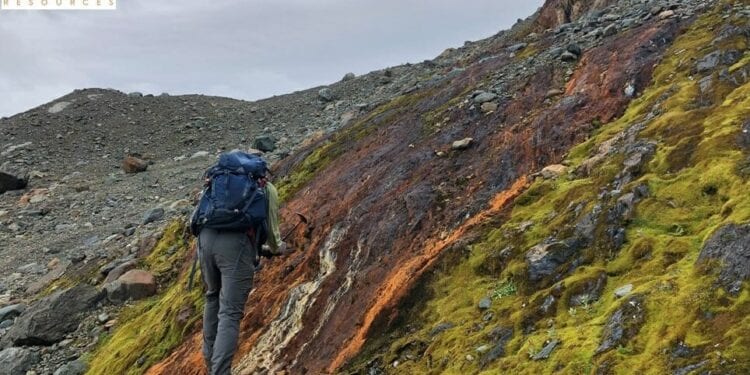Two Newly Discovered Large Conductive Targets In BC
Etruscus Resources Corp. (CSE: ETR) has discovered a new high-priority mineralised zone on the company’s Rock & Roll property, located in the Eskay Camp of BC’s resource-rich Golden Triangle of British Columbia.
The two targets along the “Hurricane” were discovered as a result of a VTEM airborne survey completed during the 2020 exploration season.
The Hurricane represents two strong geophysical conductors located on recently staked claims, 15 km northwest of the Black Dog Deposit. Upon receipt of VTEM© data, Hurricane was immediately upgraded to high-priority due to its location within favourable Black Dog stratigraphy of the Upper Stuhini Group and was followed up with sampling, prospecting and mapping during the 2020 exploration season.
The recent discovery of Hurricane was only possible due to major glacial retreat. Previous glacial cover inhibited any meaningful historical exploration. But, with recent exposure of these highly prospective targets, follow up exploration to preliminary sampling will be prioritized in the 2021 exploration season.
Hurricane Highlights:
- VTEM uncovers conductive trend of approximately 3.3 km by 0.5 km with two stronger lobes concentrated along this strike length. Conductance levels were shown to be very similar to those that overlay the Black Dog Deposit;
- The Upper Stuhini stratigraphy is fertile for VMS as well as possible epithermal mineralization. This package of fine-grained calcareous sediments, black argillite and marine volcanic rocks closely resembles the rocks that contain the Black Dog Deposit
- 743 ha was staked to cover ground hosting the second conductor. The company now owns claims surrounding both conductors; and
- The company plans to implement an extensive exploration programme, commencing in early 2021. Phase 1 will focus on a significant length of the conductors that has yet to be mapped, prospected or sampled. A drilling program is planned for Phase 2.
During the 2020 exploration season, the company completed geochemistry, grab samples and trenching on a number of key areas along Hurricane’s 3.3 km strike length. Initial geochemistry rock sampling received to date produced anomalous silver and copper results. Further results from grab and trench samples are expected in the immediate term.
The recently mapped geology surrounding the Hurricane targets is very similar to that which hosts the Black Dog Deposit. Both areas are overlain by limestone packages, contain a unique crystal lapilli tuff and black carboniferous argillites/mudstones.
Dr Dave Webb, Vice President, Exploration, said this lends itself to the possibility that the conductors picked up by the new VTEM data represents another lens in the Black Dog system.
“We are optimistic about the Hurricane conductors,” Dr Webb said.
“It is situated in prospective stratigraphy, known to host precious metals rich VMS mineralisation.
“We have identified two conductive targets at Hurricane: one 800 m long and 250 m wide and a second occurring 900 m farther along strike 420 m long and up to 150 m wide.
“Both targets correspond to very low magnetic responses, similar to the Black Dog Deposit located 15 km to the southeast.
“Our reconnaissance work had planned to assess the Stuhini rocks on our property for evidence of additional VMS targets, and initial assessments shows concentrations of elements associated with VMS targets.
“With very limited historical work done in the area and with new data from the first-ever VTEM, the Hurricane represents excellent potential for new, high-grade mineralisation.”











